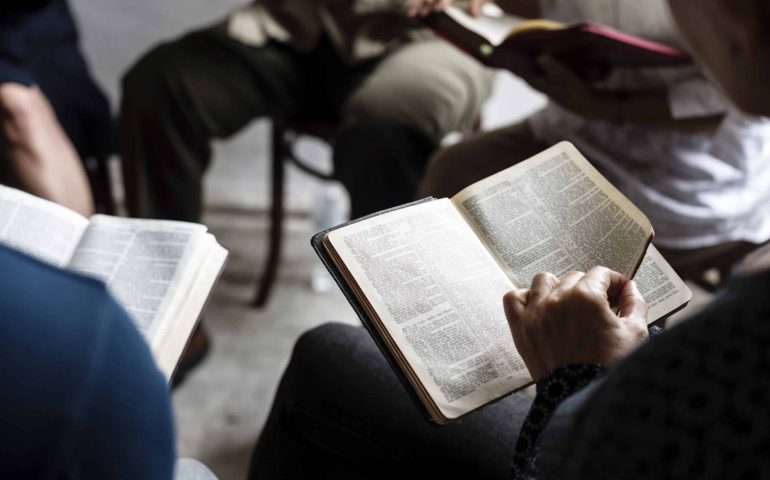It is clear in the New Testament that every member of the ekklesia (assembly or congregation) should participate in gatherings to edify and encourage one another as they assemble. In fact, this was normative. Believers expected to have the privilege and obligation to bless each other using the gifts the Holy Spirit had given them. It was not a cultural thing. It was a Spirit thing.
Yet for all this clarity, why is it so rare, being supplanted by other traditions such as making one-directional preaching the centerpiece of an assembly – a practice that has almost zero support in Scripture?
In recent years, there have been many good books, studies, and recent blogs that are taking us to task over this sad and harmful distortion at the heart of the life of the ekklesia. I am thankful for this. This blog is not a study or meant to go over that same material. I urge you to do a web search on “every member involvement church ekklesia” where you will find many good resources.
My focus in this blog is to provoke you to such a study by posing three questions.
What was the source of teaching and edifying?
The wording is unmistakable. We are members ‘one of another’. We are each given gifts for the edifying and encouraging of one another by the Spirit. We do this when we gather. The lesser members (those who are uneducated, less intellectual, poor, young, and so on) are actually of more importance. Isn’t that amazing? This flips on its head the paternalistic attitudes of many pastors who feel they have the answers and need to rescue people from false doctrine.
Don’t get me wrong. Teaching and leadership are important within an assembly. But they come from within, through the gifts of the Spirit. They are among the diverse gifts that God blesses each community and each person with and are developed through experience and training.
Typical churches offer a type of consumerism that enables people to soak in good teaching so you can be a better person. It also forgets the mystical beauty of the ekklesia as the Bride of Christ, the fullness of Christ, and the priesthood of all believers. We are called to oneness, modeled after the oneness between the Father and the Son. The inter-dependent ministry by the Spirit in each other’s lives is essential to this oneness.
When we say ‘every member involvement’, we don’t mean that the important work is done by professionals and that everyone in the church should find volunteer roles to help out. We are talking about the actual Spiritual ministry going from one to another.
When the Apostle Paul writes to the Corinthians and others with this kind of teaching, it’s striking that he is not addressing the leaders and telling them what to teach. He’s addressing the family, which includes those with elder responsibilities. In short, the community as a whole was responsible for teaching one another.
What kind of structure allowed this to happen?
Many would read the above writings about church and perhaps agree. But in the end, say it’s impractical. I think part of the reason for this is that it’s rare and almost unthinkable. Church in the form we know causes warm feelings, nostalgic memories, and provides an undemanding sense of comfort. It’s hard to give up!
We’ve essentially organized ‘every member involvement’ out of the program. There’s no room for it. No space. No practice. And thus a lack of imagination and skill about how to exercise it. It breaks our romantic experience of church.
The physical spaces we use are set up in speaker–audience format. The programs (services) are tightly designed to exclude ‘every member involvement’, with a rhythmic pattern of a certain number of songs, a sermon, offering, announcements, and benediction – almost the same everywhere with limited variations. And then there’s the drive for bigger and better churches (meaning more numbers, more money, and better sound systems). This also works against ‘every member involvement’.
So, what if we had smaller churches where everyone had a chance to speak, share, and minister? What if the program was informal enough so that it was natural to interact and minister to each other? And what if the space was designed to show that everyone is equally important (circles rather than pews)?
Why can’t we do it differently today, since we are more evolved and modern?
If Christ is a myth, then the Church is a myth, kept alive by man-made religion. If Christ is the risen Son of God, and He is the Head of the Church; His Spirit lives within each of us for the teaching, edification, encouragement, and love of one another, then we, as believers AND the institutional church and the ekklesia must corporately repent, kneel, bow down and submit to His Lordship. We must submit all that we are to Him. If this means changing something we do or believe, no matter how long we’ve done it, so be it.
In closing…
If we design a form of body that does not conform to the Body of Christ, taught and empowered by the Spirit, then we run the danger of creating a counterfeit. In essence, we risk worshipping a version of church that we desperately are trying to keep alive (idolatry) and may grieve the Spirit in the process. Yes, I know those are strong words. I would not have said those words a mere couple of years ago. But the more I witness the fight to keep man-made traditions and ignore much of the call to ekklesia in Scripture… I truly wonder.

